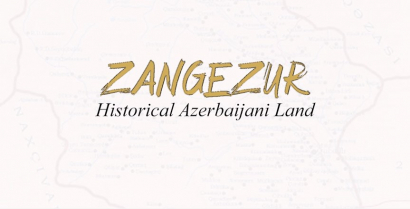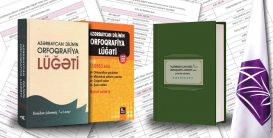Zangezur - Historical Azerbaijani Land

The Azerbaijan State Translation Centre (AzSTC) has produced a documentary archival video footage “Zangezur - Historical Azerbaijani Land” about the history of the ancient Azerbaijani land, which in parts had been annexed to Armenia with the military and political support of foreign forces since the beginning of the 20th century.
AzSTC has sent the video footage with subtitles in Azerbaijan, English and Russian languages to accredited foreign embassies and consulates to the Republic of Azerbaijan, as well as distributed among influential global internet and social networks.
“History is history. The Armenians, who celebrated the 150th anniversary of their settlement in Karabakh in 1978, are well aware that they had come to these lands as guests. Not only Nagorno-Karabakh, but also the historical lands of present-day Armenia were formed on the territory of Azerbaijan. Irevan Khanate and Zangezur region are our historical territories. If we look at a map, we will see that the great Turkic world was geographically divided as a result of the separation of Zangezur from Azerbaijan and its transfer to Armenia. In other words, the transfer of Zangezur to Armenia had a very negative sense. Presently, we don’t claim that these lands should be annexed to Azerbaijan. Nevertheless, every Azerbaijani, every citizen, every child should know his/her history. They should know that these regions are historical Azerbaijani lands.
Ilham Aliyev
President of the Republic of Azerbaijan
Zangezur, one of the ancient regions of Azerbaijan, covers an area of 7824 square kilometres and includes Goris, Sisian, Kapan and Mehri districts of modern Republic of Armenia, Lachin, Gubadli and Zangilan districts of the Republic of Azerbaijan.
The word ‘Zangezur’ is a toponym of purely Turkish origin. ‘Zangi’ is the name of an ancient Turkic tribe, and today it is the source of many geographical names, including the names of villages, rivers and mountains in this area, such as Zangichay, Zangitepe, Zangerik, Zangishamly, Zangana, Zangilan, Zangeran, Zangishali, Zangi Chay, Zangibasar, Zangilar, Zangan, Zanjan, Zangilli, to name a few.
The name of this Turkic tribe often appears in the works by Mahmud Kashgari, Rashidaddin Fazlullah, Abbasgulu aga Bakikhanov and other world-famous historians. ‘Sur’, the second lexeme of the word ‘Zangezur’, means ‘mountain, ravine and rock’ in ancient Turkic languages and characterizes the relief of a mountainous area inhabited by Zangis.
In historical sources, memoirs, and studies of ancient travellers, Zangezur is presented as the Turks’ birthplace.
Certain events described in the Book of Dede Gorgud happens in Zangezur. Names of many places, individuals, and tribes mentioned in the book such as Goris, Angalayuz, Dondarly, Ulashly, Gundanly, Akarak, Boynakar, Basat River, Gapijik Mountain, Ichaghiz and Dashaghiz caves/grottos, Aghgaya, Garagol, Garadagh, Aghduz, Garayer, Aghdere, Aghgaya, Aghbulaq, Garagaya, Garasu, Garachay, Gara dere, Qarahun dere, Khojik, Aghhasar, to name a few currently exist in Zangezur,.
Today, the facts that are reflected in many historical studies and archival documents negate unfounded accusations of fake Armenian historians who could not “armenize” the toponym “Zangezur” via baseless allegations, disseminating “The Etymology of the Name “Zangezur” is not Clear” through Wikipedia and websites.
A Brief Chronology of the History of Zangezur
Along with historical sources, in studies and researches carried out by many world famous scientist the territory of Zangezur was subordinated to: the Albanian state and later the Sassanid Empire and the Arab Caliphate in the 4th – 9th centuries BC; the ancient Azerbaijani states that won wars against the Arab Caliphate and existed in these territories for centuries under different names, such as Sajids, Salaris and Ravvadis states in the 9th-11th centuries; the State of Azerbaijan Atabeys in the 12th and in the early 13th centuries; the state of Hulakids (Elkhanids) in the 13th -14th centuries; the Jalayirid Sultanate in the 14th; and later the Qara Qoyunlu and Aq Qoyunlu states in the 15th century; the powerful Safavid state in the early 16th-century; and the ancient Karabagh Khanate of Azerbaijan in the 18th and the first half of the 19th centuries during khanates’ reign.
Historical documents and facts based on other studies carried out on the history of Zangezur prove that 115 Muslim villages in Zangezur, which were captured by Armenian armed groups in 1905-1907 and 1914-1920, were plundered, burned and destroyed, and 4472 women and children were brutally killed by Armenian militants.
Although Zangezur was declared a 'disputed territory' between Azerbaijan and Armenia by the decision of the Caucasian Bureau of the Communist (Bolshevik) Party of Russia dated August 10, 1920, not a single Azerbaijani participated in this decision. Thus, Zangezur was annexed to Soviet Armenia at the meeting of the Communist (Bolshevik) Party of Azerbaijan on November 30, 1920.
As a result of this decision Nakhchivan region was separated from the rest of Azerbaijan, and it lost its land links with Turkey, as well as with the entire Turkic world.
By the decision “Administrative Structure of the Muslim Part of Zangezur Region” issued by the Political and Organizational Bureaus of the Central Committee of the Communist (Bolshevik) Party of Azerbaijan dated January 12, 1921, Zangezur region was divided into two parts - Western and Eastern Zangezur. So, 4505 square kilometres of Zangezur region out of 7824 square kilometres was annexed from Azerbaijan and transferred to Armenia (Kapan, Goris, Garakilsa and Mehri districts.) As Zangezur was divided into districts in accordance with the decision issued by Moscow in 1933, the name ‘Zangezur’ was removed from the map in 1933.
The historic victory of the victorious Azerbaijani army in the Second Karabakh War finally restored justice. By the decree dated July 7, 2021, signed by Ilham Aliyev, President of the Azerbaijan Republic and the Supreme Commander of the Armed Forces, the creation of the “Eastern-Zangezur Economic Region” was approved.
This historical decree, which is carved in golden letters in the history of Azerbaijan, brought back the ancient name “Zangezur” on a map as a geographical and administrative-territorial unit.
October 26, 2021 - another step towards the restoring of justice - went down in history with the laying of the foundation of the Zangezur corridor in the Azerbaijani part, which unites the entire Turkic world and creates a new reality in Azerbaijan and the region.
AND OTHER...
-
 Movlud Movlud’s Short Story on Turkish Portals
Movlud Movlud’s Short Story on Turkish Portals
“Detayhaberler.com”, “Dibace.net” and “Haber.232.com”, leading Turkish portals, have posted in Turkish the short story “We Have Already Grown Up” by the...
-
 The Book “The Classification of Words Extracted from “The Spelling Dictionary of the Azerbaijani Language” Out
The Book “The Classification of Words Extracted from “The Spelling Dictionary of the Azerbaijani Language” Out
The Azerbaijan State Translation Centre has published a voluminous book “The Classification of Words Extracted from “The Spelling Dictionary of the Azerbaijani Language”
-
 Ambassador Carlos Enrique Valdes de la Concepcion: A New Stage in Azerbaijani-Cuban Literary Relations Begins
Ambassador Carlos Enrique Valdes de la Concepcion: A New Stage in Azerbaijani-Cuban Literary Relations Begins
On April 03, 2024, the Ambassador Extraordinary and Plenipotentiary of the Republic of Cuba to Azerbaijan, Carlos Enrique Valdes de la Concepcion, visited the State Translation Centre.









